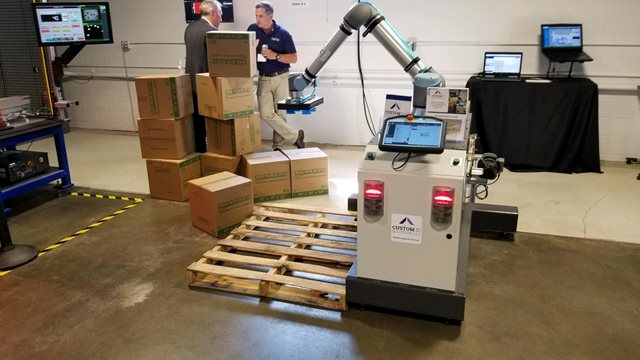
- Share
How To Maximize Manpower with Collaborate Robot Palletizing
Operators at the end of a line manually stacking cartons on to a pallet is a drain on manpower. This manpower can be better repositioned in value-add operations.
Traditional automated palletizing solutions are pricey, complex and require a significant amount of floorspace. Centralized palletizers add significant infrastructure cost and eat up more floor space. Additional cost and footprint are required due to the safety fencing for these systems.
What if we could provide a solution that was less pricey, less complex and had a small footprint? Add in the ability to be mobile allowing it to be shared across multiple lines? And require no safety fencing? The solution is collaborative robot palletizing.
Collaborative robots, also known as cobots, don’t require safety fencing because the forces and speeds they function at are too low to cause injury. This eliminates cost, space and complexity. Now envision an end of line palletizing system that can fit in about the same footprint where the current manual palletizing process takes place.
Of course, the number one question is “how much?” Depending on options and specs, this solution averages to a 1 time investment of about $175,000.
Calculating based on an average year (8 hours/shift, 5 shifts/week, 52 weeks/year) at an avg. labor burden rate of $37.46 (source), we see that:
As you can see, even the most conservative estimate gives you a complete ROI in just over 1 year.
We understand the major issue you face is not so much the cost of labor but more so the ability to find labor. However, if the current labor shortage has forced your to turn down sales because of insufficient manufacturing capacity, automation are worth the investment.
Traditional automated palletizing solutions are pricey, complex and require a significant amount of floorspace. Centralized palletizers add significant infrastructure cost and eat up more floor space. Additional cost and footprint are required due to the safety fencing for these systems.
What if we could provide a solution that was less pricey, less complex and had a small footprint? Add in the ability to be mobile allowing it to be shared across multiple lines? And require no safety fencing? The solution is collaborative robot palletizing.
Collaborative robots, also known as cobots, don’t require safety fencing because the forces and speeds they function at are too low to cause injury. This eliminates cost, space and complexity. Now envision an end of line palletizing system that can fit in about the same footprint where the current manual palletizing process takes place.
Of course, the number one question is “how much?” Depending on options and specs, this solution averages to a 1 time investment of about $175,000.
Calculating based on an average year (8 hours/shift, 5 shifts/week, 52 weeks/year) at an avg. labor burden rate of $37.46 (source), we see that:
- …for 1 operator working 2 shifts would cost you $155,833.60 per year (ROI in 1.12 years)
- …for 1 operator working 3 shifts would cost you $233,750.40 per year (ROI in 0.75 years)
- …for 2 operators working 2 shifts would cost you $311,667.20 per year (ROI in 0.56 years)
As you can see, even the most conservative estimate gives you a complete ROI in just over 1 year.
We understand the major issue you face is not so much the cost of labor but more so the ability to find labor. However, if the current labor shortage has forced your to turn down sales because of insufficient manufacturing capacity, automation are worth the investment.

